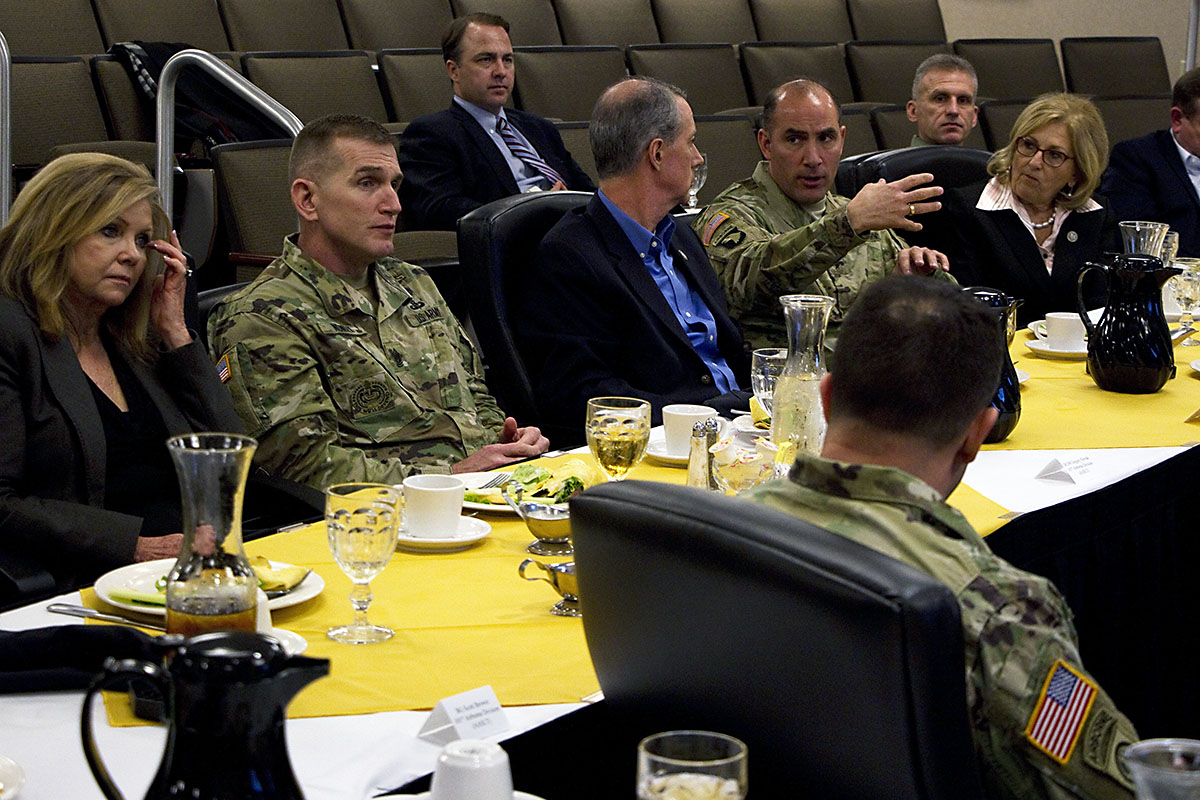Written by Sgt. William White
101st Airborne Division (Air Assault)
 Fort Campbell, KY – A congressional delegation visited Fort Campbell Tuesday in an effort to better understand readiness challenges the Army is facing.
Fort Campbell, KY – A congressional delegation visited Fort Campbell Tuesday in an effort to better understand readiness challenges the Army is facing.
House Reps. William “Mac” Thornberry, chairman of the House Armed Services Committee, Diane Black, chairwoman of the House Budget Committee and Marsha Blackburn of Tennessee and chairman of the subcommittee on communications and technology, visited some of Fort Campbell’s facilities in need of updates.
The delegation met with Maj. Gen. Andrew P. Poppas, commanding general of the 101st Airborne Division and Fort Campbell, who discussed with them the installation’s readiness challenges.

“As one of the most deployed divisions in the Army we have to stay at the height of readiness and we made some difficult decisions as the Army drew down,” Poppas said. “Priority No. 1 is every Soldier and every unit is fully trained, equipped and ready to execute the mission.”
While the division narrowed its focus during the drawdown, some issues became more prominent.
Aviation is stretched
During their visit, the delegation met with Col. Craig Alia, 101st Combat Aviation Brigade commander, at Sabre Army Heliport. Alia highlighted obstacles facing the aviators of the 101st CAB.
When the CAB deployed to Afghanistan, their maintainers were left in the rear, missing out on more than a year’s worth of developmental experience. In addition, the inactivation of the 159th CAB has increased the operational demand on qualified air crews.
“When you talk about not turning wrenches for a year or more … folks continue to get promoted, they’re still doing their jobs. So now, not only do you have junior maintainers who haven’t done it, but some of the supervisors don’t have the repetitions to build experience either. So what you have is inexperienced supervisors, inexperienced maintainers and that increases risk.” While Alia’s unit wrestles with atrophied skills, their demand to support combat training center missions has increased.
The force is stressed, Alia said. Where it used to be three companies would support three different CTC rotations, the number of qualified crews has decreased, while the demand for support has not, at least not proportionally.
Facility readiness
Last year, Fort Campbell leadership concluded that updating the Logistics Readiness Center was one of the post’s top priorities. Because of budget constraints, the proposed updates remain on hold.
The LRC provides supply, maintenance, transportation and ammunition to the division and supported units on post. The same buildings in which Fort Campbell’s military equipment is updated are in need of an update themselves.
Col. James “Rob” Salome, garrison commander, and Mark Bean, chief of installation maintenance division of the LRC, spoke with the congressional delegation about the failing condition of LRC facilities, some of which were built in 1942.
“We’ve already had to vacate two of our six main buildings, one of those has already been torn down,” Bean said.
Salome indicated that the wooden trusses that support the building are in failing condition, which is a safety concern for the facilities’ workers.
Salome also outlined a proposal for a consolidated maintenance facility. The cost to build the new consolidated facility is approximately $54 million, Bean said. A new facility could save a little more than $500,000 each year considering the costs associated with the disbursement of these facilities as well as the additional cost to the installation’s Directorate of Public Works in maintaining the older buildings.
The way ahead
The division commander and key staff highlighted the 101st Airborne Division’s challenges and priorities to the representatives.
“I think we had a very good dialogue, we had the commanders involved. We brought them to see different areas, different professions from maintainers to pilots to Soldiers who have fought and returned,” Poppas said. “I think for them it painted a very good picture of where the 101st is and what our capabilities are, where we need to go and the support we need from them.”
While the Army awaits numbers from Congress, Poppas said his focus remains on the mission.
“That’s where my focus has to be to ensure we are prepared,” he said.
The 101st Airborne Division remains capable of supporting its missions because of its Soldiers, Poppas said.
“What hasn’t changed from 1942 is the legacy of heroism that continues on,” he said. “The greatest complaint I have is that [101st Airborne Division Soldiers] want to deploy. They came in the Army during a time of war. They want to make sure they have the opportunity to serve.
“As one of the most deployed divisions, we must remain at the height of readiness,” Poppas said. “We fight where we are told, we win where we fight. We are a premiere fighting force, even today as we are in the fight we are always preparing to go again.”



